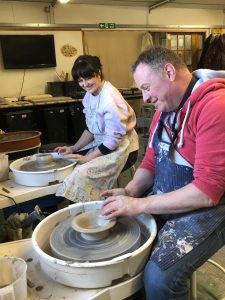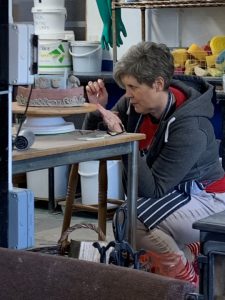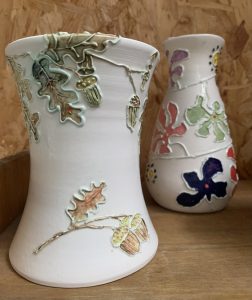Step by step guide
Decorative Materials for Ceramics
The 3 stages of ceramics
Raw or Greenware. This is the basic clay that we use to model. It is unfired.
Bisque or Biscuit ware. This is where the clay has received a firing up to 1000 degrees. It turns the raw clay into ceramic, but it is still slightly porous at this stage.
Glazed ware. This is where the bisqued pieces are fired to a higher temperature. In the case of our clay – which is either some form of stoneware or porcelain – the temperature is 1220 degrees. After this temperature firing the ceramic is no longer porous (which is why garden ornaments that are frost safe are stoneware, whereas terracotta planters have to be protected from frost as they are still slightly porous.
Decorative glazes that can be used on greenware
Clay slips
Slip is a liquefied suspension of clay particles in water. Slip is usually the consistency of double cream. We buy ready made clay slips from suppliers as this ensures consistency of colour and it is fiddly to make your own slip, although entirely possible if that floats your boat!
We buy ours in 500 cc tubs from Potclays https://www.potclays.co.uk/clays-slips-grogs/clays-slips-grogs-coloured-decorating-slips. They average at £6.00 per tub and they last for ages.
The best way to apply slip to a piece is several coats. Leave to dry completely between each coat, we’d recommend 3 or 4 coats at least to avoid a streaky appearance under transparent glaze.
There are different ways to decorate with slip, one of the most skilled decorative methods is ‘Slip trailing’ where the slip is pushed through a nozzle to create patterns on the greenware. Look up slip trailing ideas on Google and you will find lots of images and videos to introduce you to this fun, but tricky technique.
Engobes
Slips are most commonly known for being just a mix of clay and water and usually a colourant, such as an oxide or a stain. An engobe has a similar make-up to slip but is produced with less clay than a slip; the rest of the ingredients of an engobe are made up of flux or silica. Flux helps the process of making the clay liquid and also lowers the melting point of silica. We’ve included engobes in this list as you will come across the term as you are trawling websites, but we don’t presently use engobes at the studio. One of the advantages of engobes is that they can be used on bisque items as well as greenware. It’s a sort of cross between a glaze and a slip.
Underglazes
I make no apology to admitting that underglazes are my favourite form of decoration on pieces that are not raku/smoke or pit.
Underglaze is a method of decorating pottery in which painted decoration is applied to the surface before it is covered with a transparent ceramic glaze and fired in a kiln. Underglaze decoration uses pigments derived from oxides which fuse with the glaze when the piece is fired in a kiln.
These are flexible in so many ways. You can use them on greenware or bisqueware, they tend to stay true to colour during firings, they don’t run into each other, you can get a huge range of colours. Anyone who wants a painterly effect will love underglazes, as do those who would like to sponge, spray, flick etc.
The downside is that they are expensive which is why we don’t stock them in the studio as to buy them in quantity would run into hundreds of pounds. However, if you are keen on clay then the sensible thing to do is to start to build up your own collection. A 59cc pot goes a very, very long way, so we would only recommend buying a 500cc pot of white and black underglaze, and use the smaller pots for all other colours.
https://www.potclays.co.uk/ready-mixed-glazes-colours-pencils-crayons/ready-mixed-glazes-colours-pencils-crayons-amaco-velvet-underglaze-colours We recommend the Amaco Velvet underglazes as we know they fire nicely up to 1220 degrees.
Wonderglaze
We use Stroke and Coat Wonderglaze at the studio.
Probably the most versatile product of all. It can be applied on greenware, and bisque, and used in every decorative way imaginable. One coat will create a translucent finish with subsequent coats increasing opacity. We suggest 2-3 coats for opacity and all over coverage. Let dry between coats. Stroke & Coat® glazes will fire to a gloss finish without clear glaze. However, if desired, a clear glaze may be added. For application on raw clay, and bisque, you need to leave the area where it is going to sit in the kiln unglazed, as you would with a glaze. Stroke & Coat® glazes will maintain their colour at higher temperatures, especially reds, oranges, yellows, greens and blues.
Relatively expensive, but not as much as underglaze, a 59ml pot will cost about £4.00, but wonderglaze does not go nearly as far as underglaze for the same amount, so probably works out more expensive than the same size underglaze.
Oxides
You get better results with bisqueware but where to start? Of all the materials we have listed on this step by step guide, Oxides are the only ‘raw chemicals’ to be included. Oxides form the base for colour in many slips and glaze recipes, and diluted can be used directly onto the bisqueware to provide a wash of colour, and to pick out lines and highlight decorative markings.
We must stress that Oxides are usually TOXIC, so you must use care when dealing with them, wearing gloves when using the diluted oxides, and a mask as well as gloves when mixing them into water or into a glaze recipe. We have a full range of Oxides in the studio.
If you google Oxide Wash Ceramics images you will see hundreds of ways that oxides are used on Ceramics. Most Oxides are very inexpensive to buy in their powdered form – some are more expensive than others. Easy to make up – just add water and stir. Use a jamjar or small jar with a lid and the diluted oxide will keep indefinitely.
https://www.potclays.co.uk/oxides-basic-materials/oxides-basic-materials-oxides
Underglaze transfers
You can use underglaze transfers on both greenware and bisqueware. They have proved a big hit in our last virtual clay class, and we will probably be stocking them in the studio in the future, but don’t have them at the moment.
They are quite fiddly to perfect, but once on you will get lovely patterns on your pieces. The best way to learn about underglaze transfers is to go to https://www.bluematchbox.co.uk/underglaze-decals/ where they have a video showing you how to use them as well as a big range of transfers.
Decorative materials that can be used on Bisqueware.
Underglaze – See under Greenware for description
Wonderglaze – See under Greenware for description
Engobes – See under Greenware for description
Oxides – See under Greenware for description
Brush on Glazes
Another firm favourite for those who want to glaze specific parts of a piece in different colours.
It allows potters to have the broadest range of colours and visual effects possible on ceramics. The exceptional control that it provides makes it possible to create design elements that are more intricate than dipping. You can brush and sponge to get different effects with different brushes and sponges.
There’s no right or wrong way to glaze a ceramic with a brush, and since multilayering is possible, you can cover any imperfections or elements of the design.
Unlike dip glazing, brushing is cheaper to start because you don’t have to make buckets of different glaze to achieve multilayering on your ceramics. For the studio, we have dipping glaze as we can make that in quantity, whereas brushing glazes are normally shop bought and more expensive. Most of you will have seen our totem that we have made for Lowes, most of the pieces on that are created with Brushing glaze.
Dipping Glazes
This is what most people think of when they hear the term Glazing. Those big tubs of glaze allow pieces to be dipped in and brought out. The result should be an overall colour without streaks etc. That’s the theory…we wouldn’t recommend that people make up dipping glazes at home unless you are going to do lots and lots of it, as you have to buy a lot of raw chemicals to make up the recipes, plus sieves and tubs. We have a basic range of colours at the studio, including the most popular of all, Transparent.
All forms of Raku/Smoke and Pit Firing
Raku is the best known of the alternative firing techniques where bisqueware is painted with special raku glazes and then heated to 1000 degrees in a gas fired raku kiln. The pieces are removed at that temperature and then cooled in the air, or by spraying water on them, creating the trademark crackled effect and vibrant raku colours. An exciting and rather dangerous way of decorating with a high mortality rate for pots that can explode with the thermal shock.
Smoke firing is just that, pots are put into a bin and then smoked for at least 8 hours with the result being brown/cream/black with hints of red or yellow depending upon the organic materials that are in the bin with the pieces.
Pit firing is smoke firing on Steroids. Wood is used to create a lot of heat in an actual pit, and the pots are usually wrapped in ‘Saggars’ usually tinfoil with organic matter wrapped tightly against the pieces. The wood is kept burning to a high temperature for two or three hours, and then the pit is covered to allow for ‘cooking’ for a further few hours. The colours can be amazing, with blues, reds, yellows and pinks appearing on the pots. Again, not for the fainthearted as the failure rate can be extremely disappointing due to cracks from thermal shock.
Underglaze transfers – See under Greenware for description
Glazeware
Ceramic Transfers
Once the item is glazed that is usually that, it is the finished piece. However, you can use Ceramic Transfers onto glazed pieces. This requires a third firing. The transfer is applied and then the piece is refired to about 800c to set the transfer.
Lustres
Again, applied after the item has been glazed and then re-fired to 800-850c. The results can be absolutely beautiful, with glorious mother of pearl sheen to gold rims. However, lustres are extremely expensive, so to be used as a sort of very special treat!
Glazeware
Decorating Slip (greenware)
Potclays – https://www.potclays.co.uk/clays-slips-grogs/clays-slips-grogs-coloured-decorating-slips
Underglaze (bisque)
Wonderglaze – (green or bisque)
Underglaze transfers (green or bisque)
BlueMatchBox – https://www.bluematchbox.co.uk/underglaze-decals/
Brush on glazes (bisque)
Lustres

Wheel Throwing Courses
Aimed at both beginners and those who wish to improve their throwing skills.

Clay Classes
We offer small classes of 8 people. The classes are suitable for beginners and more experienced alike.

Open Studio
Cheshire Clay Studio are proud to be able to display our class members and class leaders work through Open Studio weekends.
Address
Cheshire Clay Studio,
Lowes Farm
Moss Lane
Middlewich
Cheshire – CW10 9NG
Contact Us
07931 351183
